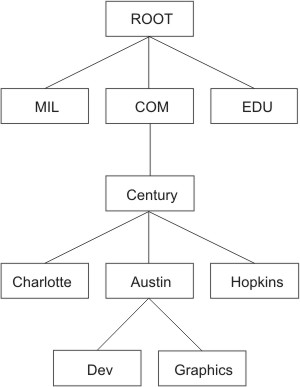Name servers
In a flat name space, all names must be kept in the /etc/hosts file on each host on the network. If the network is very large, this can become a burden on the resources of each machine. In a hierarchical network, certain hosts designated as name servers resolve names into Internet addresses for other hosts.
This has two advantages over the flat name space. It keeps the resources of each host on the network from being tied up in resolving names, and it keeps the person who manages the system from having to maintain name resolution files on each machine on the network. The set of names managed by a single name server is known as its zone of authority.
To further reduce unnecessary network activity, all name servers cache (store for a period of time) name-to-address mappings. When a client asks a server to resolve a name, the server checks its cache first to see if the name has been resolved recently. Because domain and host names do change, each item remains in the cache for a limited length of time specified by the TTL of the record. In this way, authorities can specify how long they expect the name resolution to be accurate.
Within any autonomous system there can be multiple name servers. Typically, name servers are organized hierarchically and correspond to the network organization. Referring to the "Domain Structure of the Internet" figure, each domain might have a name server responsible for all subdomains within the domain. Each subdomain name server communicates with the name server of the domain above it (called the parent name server), as well as with the name servers of other subdomains.

For example, in the "Domain Structure of the Internet" figure, Austin, Hopkins, and Charlotte are all subdomains of the domain Century. If the tree hierarchy is followed in the network design, the Austin name server communicates with the name servers of Charlotte and Hopkins as well as with the parent Century name server. The Austin name server also communicates with the name servers responsible for its subdomains.
There are several types of name servers:
| Item | Description |
|---|---|
| Master Name Server | Loads its data from a file or disk and can delegate authority to other servers in its domain. |
| Slave Name Server | Receives its information at system startup time for the given zone of authority from a master name server, and then periodically asks the master server to update its information. On expiration of the refresh value in the start of authority (SOA) Resource Record on a slave name server, or on receipt of a Notify message from the master name server, the slave reloads the database from the master if the serial number of the database on the master is greater than the serial number in the current database on the slave. If it becomes necessary to force a new zone transfer from the master, simply remove the existing slave databases and refresh the named daemon on the slave name server. |
| Stub Name Server | Although its method of database replication is similar to that of the slave name server, the stub name server only replicates the name server records of the master database rather than the whole database. |
| Hint Server | Indicates a name server that relies only on the hints that it has built from previous queries to other name servers. The hint name server responds to queries by asking other servers that have the authority to provide the information needed if a hint name server does not have a name-to-address mapping in its cache. |
| Forwarder or Client Server | Forwards queries it cannot satisfy locally to a fixed list of forwarding servers. Forwarding-only servers (a forwarder that obtains information and passes it on to other clients, but that is not actually a server) does not interact with the master name servers for the root domain and other domains. The queries to the forwarding servers are recursive. There can be one or more forwarding servers, which are tried in turn until the list is exhausted. A client and forwarder configuration is typically used when you do not want all the servers at a given site to interact with the rest of the Internet servers, or when you want to build a large cache on a select number of name servers. |
| Remote Server | Runs all the network programs that use the name server without the name server process running on the local host. All queries are serviced by a name server that is running on another machine on the network. |
One name server host can perform in different capacities for different zones of authority. For example, a single name server host can be a master name server for one zone and a slave name server for another zone.